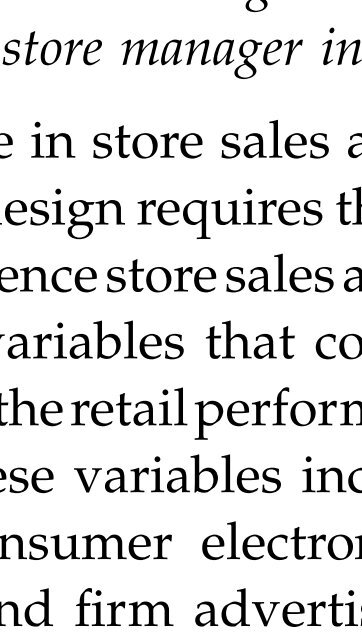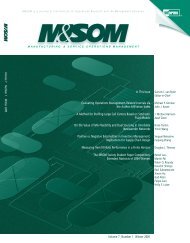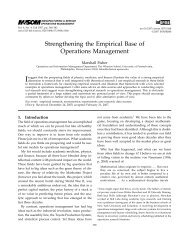Store Manager Incentive Design and Retail Performance: An ...
Store Manager Incentive Design and Retail Performance: An ...
Store Manager Incentive Design and Retail Performance: An ...
You also want an ePaper? Increase the reach of your titles
YUMPU automatically turns print PDFs into web optimized ePapers that Google loves.
DeHoratius <strong>and</strong> Raman: <strong>Store</strong> <strong>Manager</strong> <strong>Incentive</strong> <strong>Design</strong> <strong>and</strong> <strong>Retail</strong> <strong>Performance</strong><br />
Manufacturing & Service Operations Management 9(4), pp. 518–534, © 2007 INFORMS 523<br />
closed during periods of low staffing, <strong>and</strong> deciding<br />
not to open additional cash registers to expedite customer<br />
service when inventory is being delivered.<br />
In sum, store sales <strong>and</strong> shrinkage should differ<br />
when store managers are rewarded according to the<br />
BMS plan orthe Tweeterplan, as hypothesized below.<br />
When store managers are rewarded according to the<br />
BMS incentive plan, stores have lower levels of sales<br />
than when store managers are rewarded under the<br />
Tweeterincentive plan. In otherwords, there is a positive<br />
association between the change in store manager<br />
incentive plan <strong>and</strong> store sales. Reducing the penalty<br />
for shrinkage could cause store managers to shift their<br />
effort allocated from shrink prevention to sales generation<br />
<strong>and</strong> to make different process choices influencing<br />
the generation of sales in their stores.<br />
Hypothesis 1 (H1). <strong>Store</strong> sales is positively correlated<br />
with the change in store manager incentive plan.<br />
When store managers are rewarded according to the<br />
BMS incentive plan, stores have lower levels of shrinkage<br />
than when the store managers are rewarded under<br />
the Tweeterincentive plan. In otherwords, we expect<br />
a positive association between the change in store<br />
managerincentive plan <strong>and</strong> store shrinkage. Reducing<br />
the penalty for shrinkage increases the observed level<br />
of shrinkage as store managers exert less effort <strong>and</strong><br />
make different process choices influencing the prevention<br />
of shrinkage in their stores.<br />
Hypothesis 2 (H2). <strong>Store</strong> shrinkage is positively correlated<br />
with the change in store manager incentive plan.<br />
Attributing an increase in store sales <strong>and</strong> shrinkage<br />
to a change in incentive design requires that we control<br />
forotherfactors that influence store sales <strong>and</strong> shrinkage.<br />
Figure 1 illustrates the variables that could plausibly<br />
accountfor differencesintheretailperformancemetrics,<br />
sales <strong>and</strong> shrinkage. These variables include changes<br />
in retail sales for the consumer electronics industry,<br />
store inventory levels, <strong>and</strong> firm advertising expenditure.<br />
We would expect sales to increase with overall<br />
growth in the consumer electronics retail industry<br />
<strong>and</strong> with additional store inventory as stores experience<br />
fewerstockouts (Wolfe 1968). Although evidence<br />
supporting a relationship between sales <strong>and</strong> advertising<br />
is inconclusive (Lodish et al. 1995, Dekimpe <strong>and</strong><br />
Hanssens 1999, Gijsbrechts et al. 2003), we do control<br />
foradvertising expenditure.<br />
Figure 1 Underst<strong>and</strong>ing the Drivers of Sales <strong>and</strong> Shrinkage at BMS<br />
<strong>and</strong> Tweeter<br />
<strong>Incentive</strong>s<br />
Industry growth<br />
Assortment<br />
Sales<br />
<strong>Store</strong><br />
manager<br />
Turnover<br />
behavior Inventory Process/<br />
training<br />
Shrinkage<br />
Advertising<br />
<strong>Store</strong><br />
profit<br />
The factors influencing inventory shrinkage are far<br />
less developed in the existing literature. However,<br />
one could imagine that the availability of inventory<br />
in the store could also impact store shrinkage levels.<br />
Moreover, other aspects of store operations such<br />
as employee turnover (Lucas 1985), pricing policy,<br />
<strong>and</strong> product assortment might impact both sales <strong>and</strong><br />
shrinkage. Section 5 details our analytical strategy as<br />
well as the data we collected to test ourhypotheses.<br />
5. Empirical<strong>An</strong>alysis<br />
The change in ownership of the BMS stores presented<br />
us with an opportunity to observe monthly sales,<br />
monthly shrinkage, <strong>and</strong> store managerbehaviorin<br />
BMS stores both before <strong>and</strong> after the implementation<br />
of a new store manager incentive plan. Viewing the<br />
store manager as a multitasking agent who allocates<br />
effort to different activities based on the rewards that<br />
accrue from, <strong>and</strong> the cost of pursuing, each of these<br />
activities, <strong>and</strong> who makes process choices based on<br />
the rewards that accrue from, <strong>and</strong> the cost of executing,<br />
such choices, we expect store manager behavior<br />
to differdepending on the incentive policy in place.<br />
Ourobjective is to isolate the effect that changing<br />
store manager incentives had on retail performance<br />
<strong>and</strong> test the hypotheses detailed in §4. We do so not<br />
only by controlling for variables such as inventory<br />
levels, advertising, <strong>and</strong> industry retail sales growth,<br />
but also by determining that, beyond the reward




